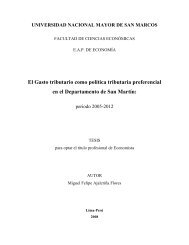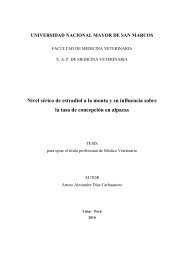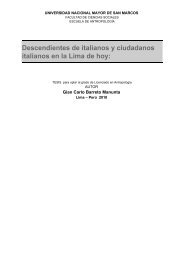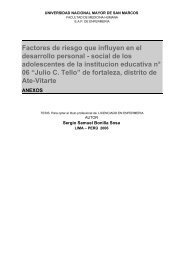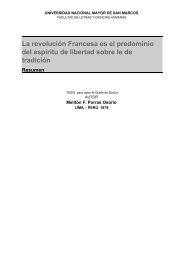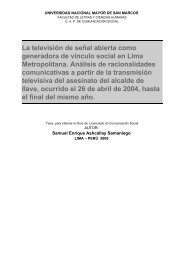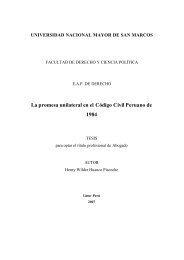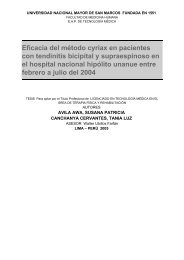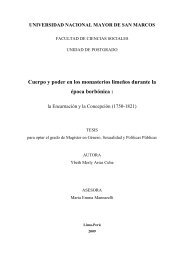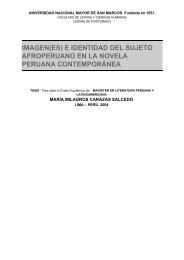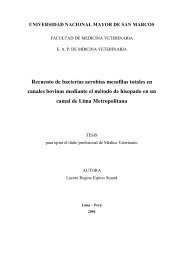Análisis de la historieta norteamericana de ... - Cybertesis
Análisis de la historieta norteamericana de ... - Cybertesis
Análisis de la historieta norteamericana de ... - Cybertesis
You also want an ePaper? Increase the reach of your titles
YUMPU automatically turns print PDFs into web optimized ePapers that Google loves.
en re<strong>la</strong>ción al nombre <strong>de</strong> <strong>la</strong> saga: “(…) él lucha para conquistar el sueño Americano,<br />
temiendo que nunca tendrá <strong>la</strong> ocasión <strong>de</strong> experimentarlo en carne propia.<br />
¿Revolución? Quizá no. Pero éste es el nuevo acuerdo” 3 .<br />
La saga compren<strong>de</strong> “Enemigo” y posteriormente “Señores <strong>de</strong> <strong>la</strong> Guerra”, entre<br />
los números dos al seis <strong>de</strong> <strong>la</strong> serie. El superhéroe, siete meses <strong>de</strong>spués <strong>de</strong> los<br />
acontecimientos <strong>de</strong>l 11 <strong>de</strong> septiembre, se enfrenta a un grupo terrorista comandado<br />
por un fundamentalista islámico: Faysal Al-Tariq que ataca y secuestra a todo un<br />
pueblo supuestamente por tener una fábrica <strong>de</strong> bombas que abastece a <strong>la</strong> milicia<br />
<strong>norteamericana</strong>, esto le otorga a <strong>la</strong> historia unas referencias parecidas al comic<br />
i<strong>de</strong>ológico y propagandístico <strong>de</strong>l Capitán América <strong>de</strong> <strong>la</strong> Edad <strong>de</strong> Oro. Algunas<br />
viñetas <strong>de</strong> esta parte <strong>de</strong> <strong>la</strong> saga, por su contenido i<strong>de</strong>ológico a<strong>de</strong>más <strong>de</strong> alusiones a<br />
conflictos bélicos entre occi<strong>de</strong>nte y <strong>la</strong> cultura musulmán, merecen comentarios y un<br />
análisis que se realiza más a<strong>de</strong><strong>la</strong>nte.<br />
El Capitán América fue un personaje nacido <strong>de</strong> <strong>la</strong> propaganda durante <strong>la</strong><br />
Segunda Guerra Mundial. En dicha época, el comic <strong>de</strong> superhéroes (Batman,<br />
Capitán América, el Submarinero Namor, F<strong>la</strong>sh, <strong>la</strong> Antorcha Humana) tuvo un<br />
consumo masivo que abarcaba el tiraje mensual <strong>de</strong> 25 millones <strong>de</strong> revistas.<br />
Constituyeron instrumentos <strong>de</strong> propaganda i<strong>de</strong>ológica para consolidar el espíritu<br />
triunfalista <strong>de</strong> <strong>la</strong>s tropas y <strong>de</strong> <strong>la</strong> pob<strong>la</strong>ción americana: estos superhéroes<br />
enfrentaban enemigos alemanes y japoneses. De 1949 a 1954, <strong>la</strong>s cifras <strong>de</strong> venta<br />
se habían elevado <strong>de</strong> 50 a 150 millones <strong>de</strong> ejemp<strong>la</strong>res al mes. Es cuando <strong>la</strong><br />
industria <strong>de</strong>l comic alcanza un enorme peso editorial <strong>la</strong> l<strong>la</strong>mada Edad <strong>de</strong> Oro entre<br />
los primeros años cincuenta.<br />
El personaje emblemático <strong>de</strong> esta etapa fue Captain America, creado por Joe<br />
Simon y Jack Kirby y puesto a <strong>la</strong> venta por Timely en 1941. Hay que anotar que esta<br />
difusión <strong>de</strong> <strong>la</strong> propaganda antinazi, militarizada e i<strong>de</strong>ológica mostraba una<br />
amalgama <strong>de</strong> realidad y ficción don<strong>de</strong> todo contexto político se veía reflejado, en <strong>la</strong><br />
segunda página <strong>de</strong> <strong>la</strong> primera entrega <strong>de</strong> Captain America (1941) el propio<br />
3 La <strong>de</strong>c<strong>la</strong>ración <strong>de</strong> Cassaday <strong>la</strong> po<strong>de</strong>mos encontrar en su página web, aquí un extracto: “I can’t say<br />
this will be a revolution and a Cap unrecognizable. However, what John Rieber and I are putting<br />
together will <strong>de</strong>liver a Captain America that has more on his mind than beating super-vil<strong>la</strong>ins-of-theweek<br />
senseless. Our Cap believes in the American standard, but you won’t catch him <strong>de</strong>livering<br />
countless syrupy speeches. Our man’s patriotic testosterone comes out of his angry fists, not endless<br />
rhetoric. A fighter, not a preacher, I want to <strong>de</strong>liver a hero you wouldn't fuck with. There's a difference<br />
between believing in a hero and a "believable" hero. Regardless of what some may think of the costume<br />
and assorted histories, I'm shooting for the <strong>la</strong>tter.<br />
Captain America doesn't just fight for the United States, he fights for the ens<strong>la</strong>ved of the world. Fighting<br />
to preserve his i<strong>de</strong>a of the American Dream, fearing he'll never have the chance to experience it himself.<br />
A soldier of few words, lugging around a bur<strong>de</strong>n of betrayal and a good measure of guilt. And it’s got<br />
nothing to do with a <strong>de</strong>ad kid-partner. Hundreds of thousands died because of our Captain. And he has<br />
much to make up for. Revolution? Maybe not. But it is THE NEW DEAL.”<br />
The Official Jhon Cassaday Site. En <strong>la</strong> siguiente dirección telemática (URL): www.johncassaday.com<br />
191




